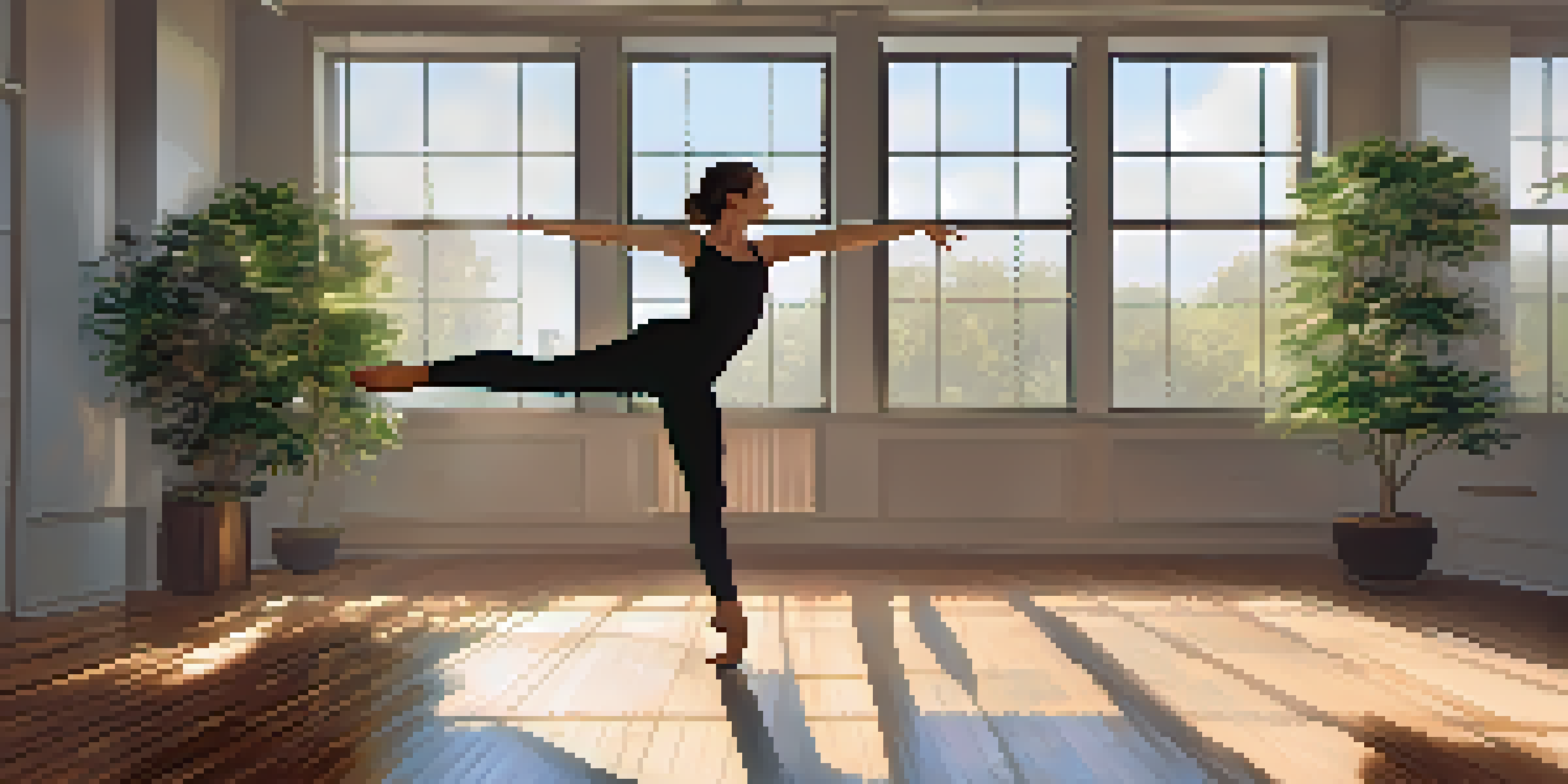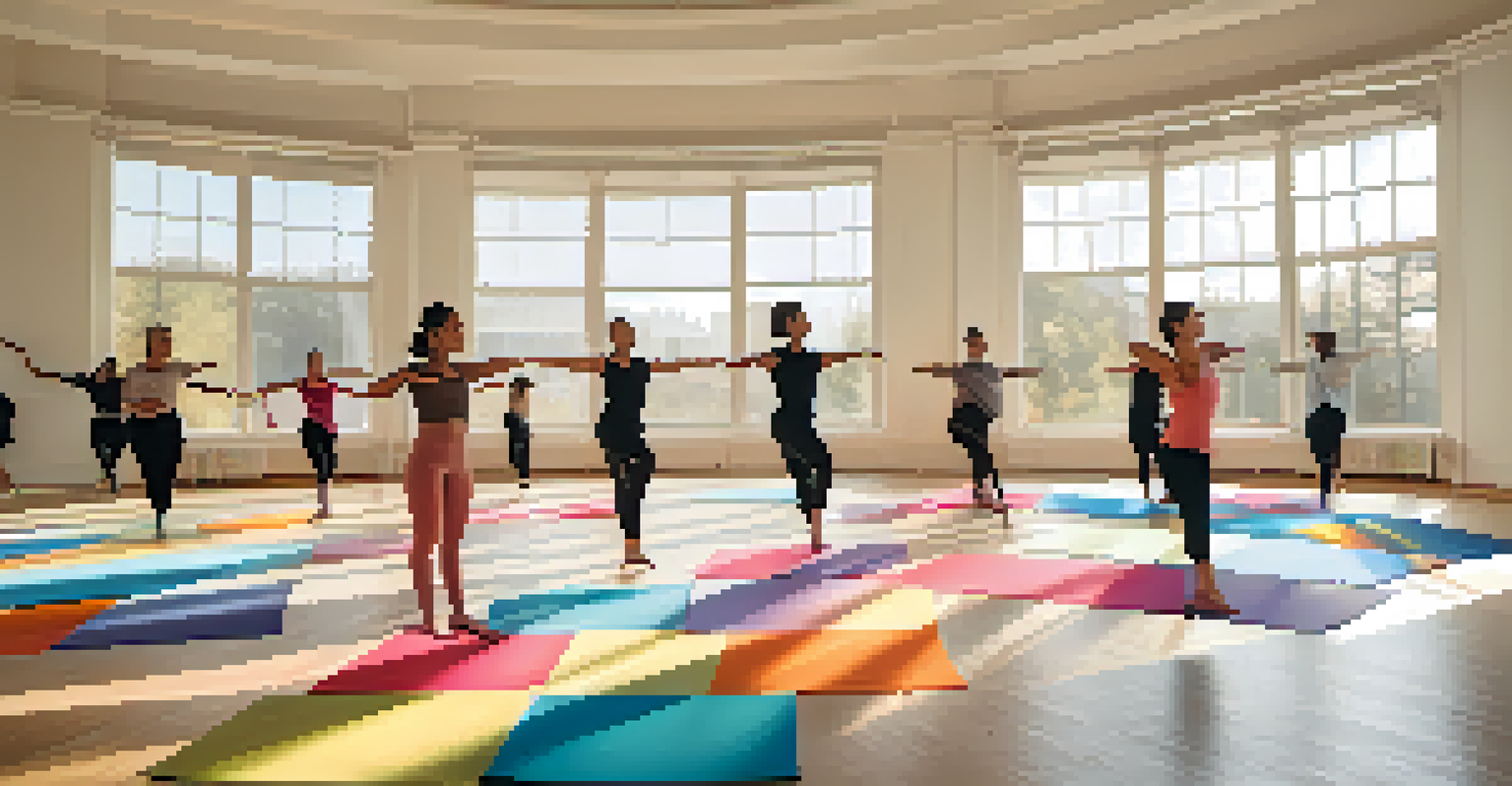Mindfulness in Dance: Enhancing Mental Focus and Awareness

Understanding Mindfulness and Its Benefits
Mindfulness is the practice of being fully present in the moment, and it can significantly enhance our dance experience. By focusing on our breath and movements, we create a deeper connection with our body, which allows us to perform with greater intention. This heightened awareness not only improves our technique but also enriches our emotional expression on stage.
The mind is everything. What you think you become.
Think of mindfulness as tuning a radio to the perfect frequency; everything becomes clearer and more vibrant. Dancers who embrace mindfulness often report feeling more grounded and less anxious, which can lead to improved performance and creativity. This sense of calm can make a huge difference, especially during high-pressure performances or auditions.
Moreover, incorporating mindfulness into dance can foster a greater understanding of one’s body and its capabilities. Through this practice, dancers learn to listen to their bodies, recognizing when to push harder or when to rest, ultimately promoting long-term physical health and well-being.
The Connection Between Mindfulness and Dance Movement
Dance is not just about physicality; it’s also about mental engagement. When dancers practice mindfulness, they become more attuned to the subtle nuances of their movements. This connection between mind and body can lead to a more fluid and expressive performance, where every gesture tells a story.

For example, consider a dancer performing a solo. By being mindful, they can harness their emotional energy and convey it through their movements, captivating the audience. This level of focus transforms a routine performance into a mesmerizing experience that resonates with onlookers.
Mindfulness Enhances Dance Performance
Practicing mindfulness can improve focus, emotional expression, and overall performance quality for dancers.
Additionally, mindfulness encourages exploration and experimentation within dance. Dancers who are present in the moment are more likely to take risks, try new styles, and discover their unique voice in dance, leading to personal growth and artistic development.
Practicing Mindfulness Techniques in Dance
Integrating mindfulness into dance doesn’t require an overhaul of your routine; small adjustments can yield significant benefits. Simple techniques like focused breathing before class or during rehearsals can help clear your mind and enhance your concentration. This practice prepares you to engage fully with your dance.
Mindfulness isn't difficult, we just need to remember to do it.
Another effective method is to incorporate a few moments of stillness into your warm-up. Taking time to center yourself and reflect on your intentions for the session can create a more mindful atmosphere. Visualization can also play a role—imagine yourself dancing effortlessly, feeling each movement resonate within.
Lastly, consider journaling your dance experiences. Reflecting on how mindfulness impacted your practice or performance can deepen your understanding and commitment to the process. This self-awareness not only improves your dance but also enriches your overall experience as an artist.
Mindfulness Enhances Performance Under Pressure
Performance anxiety is a common hurdle for dancers, but mindfulness can be a powerful tool to combat it. By focusing on the present moment rather than worrying about potential mistakes, dancers can navigate stressful situations with greater ease. This shift in mindset can lead to a more authentic and confident performance.
Imagine standing backstage, heart racing before a big performance. Practicing mindfulness techniques, such as deep breathing or grounding exercises, can help calm those nerves. By directing your attention to your body and the music, you create a sense of control amidst the chaos.
Mindfulness Aids Injury Prevention
Being mindful helps dancers recognize their physical limits, reducing the risk of injury during practice and performance.
Moreover, mindfulness helps dancers develop resilience. When faced with challenges during performances, those who practice mindfulness are better equipped to adapt and stay centered. This adaptability not only enhances their dance but also cultivates a growth mindset that embraces learning from every experience.
Building Community Through Mindful Dance Practices
Mindfulness in dance can also foster a sense of community among dancers. Participating in group mindfulness exercises, such as guided meditation or reflective discussions, encourages connection and support. This shared experience can create a nurturing environment where dancers feel safe to express themselves.
For instance, consider a dance workshop that begins with a mindfulness session. This not only sets a positive tone for the day but also helps participants bond over their shared commitment to personal growth. The result is a supportive atmosphere that allows for creativity and collaboration.
In essence, mindfulness nurtures a culture of empathy within dance communities. Dancers who practice mindfulness are more likely to approach their peers with kindness and understanding, enriching their collective experience and creating lasting relationships.
Mindfulness as a Path to Injury Prevention
Mindfulness is not just beneficial for mental focus; it also plays a crucial role in injury prevention. By being aware of your body and its limits, you can make smarter choices during practice and performance. This awareness helps you recognize when you’re overexerting yourself or when you need to modify certain movements.
For example, if a dancer feels pain while executing a particular movement, mindfulness encourages them to listen to that signal rather than pushing through it. This proactive approach can prevent injuries that may otherwise sideline them for weeks or months.
Building Community Through Mindfulness
Group mindfulness practices in dance foster connection and support, creating a nurturing environment for creativity.
Additionally, mindfulness promotes proper alignment and technique, which are essential for maintaining physical health. By focusing on how each part of your body engages during movement, you can develop healthier habits that support longevity in dance.
Embracing Mindfulness for Lifelong Dance Practice
Incorporating mindfulness into your dance practice can lead to a more fulfilling and sustainable journey. As dancers, we often face physical and emotional challenges, but mindfulness equips us with tools to navigate these hurdles. Embracing this practice can transform how we experience dance, making it more enjoyable and meaningful.
Imagine looking back on your dance journey and feeling proud of how far you’ve come, not just in skill but in self-awareness and emotional growth. Mindfulness allows for this reflection by encouraging a deeper connection with your dance experience, fostering gratitude for each moment.

Ultimately, mindfulness in dance is a lifelong practice. The more you cultivate this awareness, the more enriched your dance experience becomes, allowing you to evolve as both a dancer and an individual.